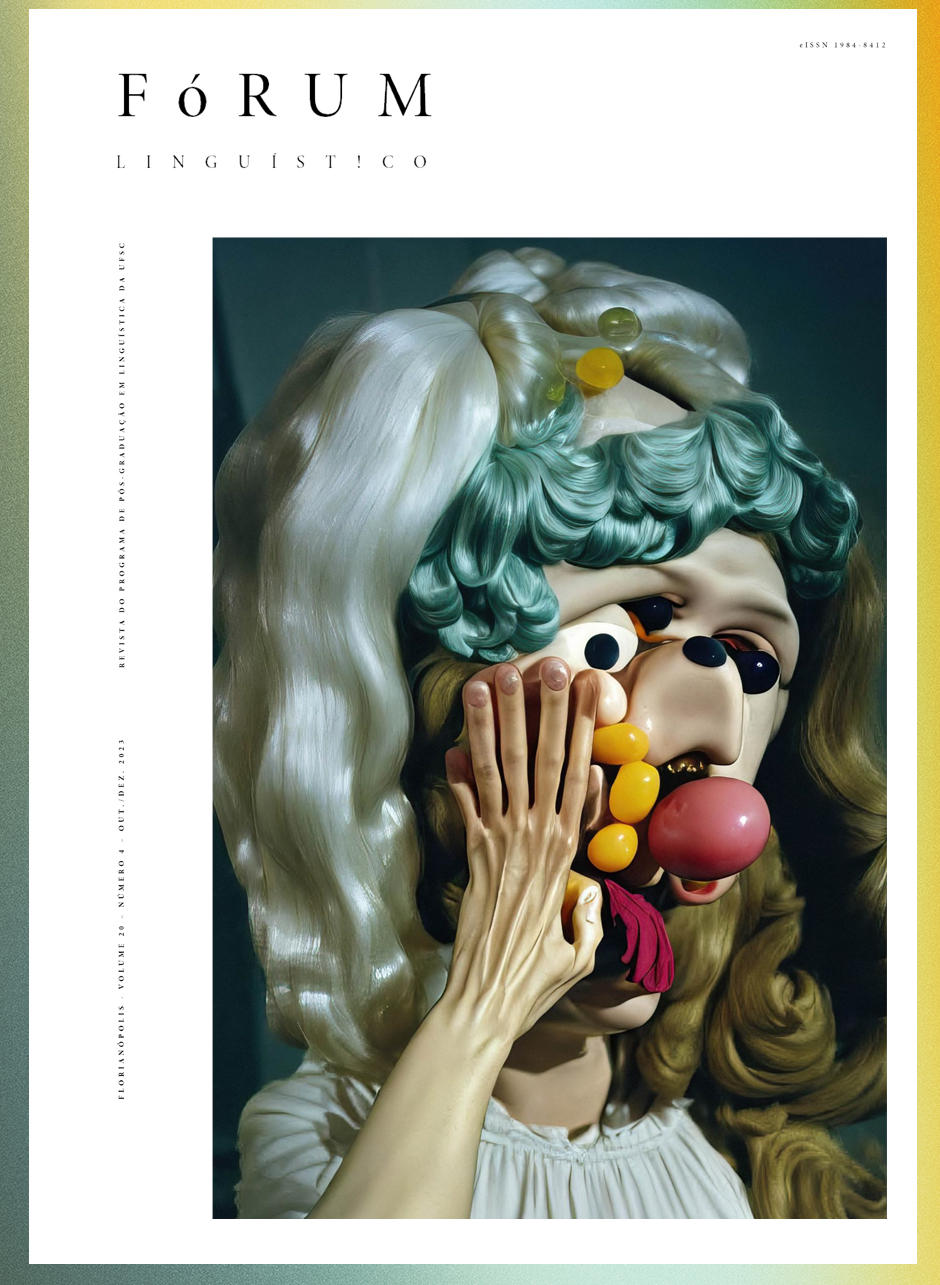A relação texto-imagem no discurso jornalístico sob enfoque da linguística crítica
DOI:
https://doi.org/10.5007/1984-8412.2023.e85517Palavras-chave:
Discurso jornalístico, Organização de elementos, Estrutura de equilíbrio, Estilo linguísticoResumo
Dada a importância e poder das notícias na sociedade contemporânea, não é surpresa que o discurso jornalístico seja tão estudado. Tal discurso possui características e métodos de produção e consumo específicos. O objetivo deste artigo é identificar a inter-relação entre textos escritos e as imagens nas capas de dois jornais impressos mineiros, produzidos durante a pandemia de Covid-19, a partir do estilo linguístico, da análise da organização dos elementos de capa, da Estrutura de Equilíbrio (EE) fornecida pelos produtores e das práticas discursivas que moldam o discurso jornalístico. Para que os objetivos sejam alcançados, busco suporte na Análise Crítica do Discurso. Por outro lado, os estudos que analisam especificamente as práticas discursivas do discurso jornalístico são de extrema importância. Os resultados apontam que: os recursos linguísticos foram ajustados ao público-alvo; as imagens estabeleceram relações importantes com os textos escritos; e o valor de notícia se mostrou importante na confecção das capas.
Referências
BAKTHIN, M. Marxismo e a Filosofia da Linguagem. São Paulo: Hucitec. 2006.
BATEMAN, J. Multimodality and Genre. Ed. Palgrave. London. 2008.
BEDNAREK, M; CAPLE, H. News Discourse. Ed. Continuum. N.Y. 2012.
BLOMMAERT, J. The debate is open. In. Language ideological debates. Ed. Mouton Gruyter. New York. 1999.
BLOMMAERT, J. Discourse: A critical introduction. Ed. Cambridge. Cambridge. 2005.
CAPLE, H. Playing with words and pictures: intersemiosis in a new genre of news reportage. Ph.D. Thesis, Department of Linguistics, University of Sydney. 2009b.
CAPLE, H. Doubling-up: allusion and bonding in multi-semiotic news stories. In. New Discourse on Language: Functional Perspectives on Multimodality, Identity, and Affiliation. Ed. Continuum. New York. 2010a.
COTTER, C. Investigating the Language of Journalism. Ed. Cambridge University Press. New York. 2010.
COX, R.W. Beyond empire and terror: critical reflections on the political economy of the world order. In. New political economy. Nº09, vol. 03. 2004. p.p307-323.
DONDIS, D. A. A Primer of Visual Literacy. London: MIT Press.1973.
FAIRCLOUGH, N. Discourse and social change. Ed. Arnold. London. 1992.
FARICLOUGH, N. Discourse and Social Change. Cambridge: Polity. 1994.
FAIRCLOUGH, N. Media Discourse. Ed. Arnold. London.1995b.
FAIRCLOUGH, N. Critical discourse analysis: the critical study of language. Ed. Longman. London. 2003.
FAIRCLOUGH, N. Analysing discourse: textual analysis research. Ed. Routledge. London. 2003.
FOWLER, R. Language in the news. Ed. Routledge. London. 1991.
GALTUNG, J; RUGE, M. Structuring and selecting news. In. The manufacture of new: social problems, deviance and the news media. Ed. Constable. London. 1965. p.p. 62-72.
GRAMSCI, A. Quaderni del Carcere. Edição crítica do Instituto Gramsci, org. Valentino Gerratana. Ed. Einaudi. Turim. 1977.
HALLIDAY, M. A. K. Language and a Social Semiotic: The social interpretation of language and meaning. London: Ed. Edward Arnold. 1978.
HALLIDAY, M. A. K. An Introduction to Functional Grammar. E. Edward Arnold. London. 1994.
HALLIDAY, M. A. K.; MATTHIESSEN, C. M. I. M. An Introduction to Functional Grammar. 3. ed. Ed. Arnold. London. 2004.
IASBECK, L. C. A. A arte dos slogans: as técnicas de construção das frases de efeito no texto publicitário. Ed. Annablume. São Paulo. 2000.
IGGERS, J. Good news, bad news: journalism ethics and the public interest. Ed. Westview press. Boulder. 1999.
JUCKER, A.H. Social stylistics: syntactic variation in British newspaper. Ed. Mouton Gruyter. Berlin. 1992.
KRESS, G.; HODGE, R. Language as ideology. Ed. Routledge. London. 1979.
KRESS, G.; van LEEUWEN, T. Colour as a semiotic mode: notes for a grammar of colour. Sage Publications. London. 2002.
KRESS, G.; van LEEUWEN, T. Reading images: The grammar of visual design. 2. ed. Ed. Routledge. London. 2006.
KRESS, G.; van LEEUWEN, T . Reading images: The grammar of visual design. 2. ed. Ed. Routledge. London. 2021.
LUKE, A. Beyond science and ideology critique: developing critical discourse analysis. In. Annual Review of Applied Linguistics, Nº 22, 2002. p. 96-110.
McLELLAN, D. Ideology. Ed. Minnesota Press. Minneapolis. 1986.
MEINHOF, U.H. Language in the age of satellite television. Ed. Oxford University Press. Oxford. 1998.
MILLS, C. Feminist stylistics. Ed. Routledge. London. 1995.
O’NEILL, J. Journalism in the market place. In. Ethical issues in journalism and the media. Ed. Routledge. London. 1992. p.p.15-32.
PHILLLIPS, L; JORGENSEN, M.W. Discourse analysis as theory and method. Ed. Sage. London. 2002.
REISIGL, M; WODAK, R. Discourse and discrimination: rhetorics of racism and anti-semitism. Ed. Routledge. London. 2001.
RICHARDSON, J.E. Analysing newspapers: an approach from Critical Discourse Analysis. Ed. Palgrave. London. 2007.
TITSCHER, S; MEYER, M; WODAK, R; VETTER, E. Methods of text and discourse analysis. Ed. Sage. London. 2000.
TUCHMAN, G. Objectivity as strategic ritual. In. American journal of sociology, vol. 77.1972. p.p. 660-679.
VIVANCO, V. The absence of connectives and the maintenance of coherence in publicity texts. Journal of Pragmatics, n. 37, 2004. p. 1233-1249.
WODAK, R. Disorders of discourse. Ed. Longman. London. 1996.
Downloads
Publicado
Edição
Seção
Licença

Este trabalho está licenciado sob uma licença Creative Commons Attribution-NonCommercial-NoDerivatives 4.0 International License.
Os trabalhos publicados passam a ser de direito da Revista Fórum Linguístico, ficando sua reimpressão, total ou parcial, sujeita à autorização expressa da Comissão Editorial da revista. Deve ser consignada a fonte de publicação original.
Esta publicação está regida por uma licença Creative Commons Attribution-NonCommercial-NoDerivatives 4.0 International License.



